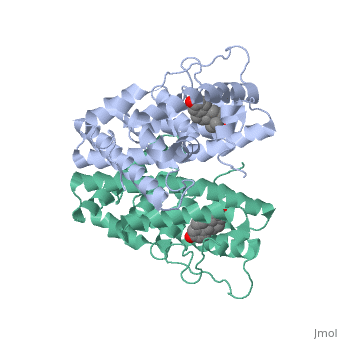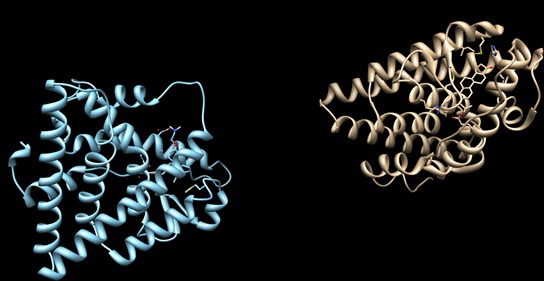Ivan Koutsopatriy estrogen receptor
From Proteopedia
(Difference between revisions)
| (13 intermediate revisions not shown.) | |||
| Line 1: | Line 1: | ||
| - | <StructureSection load='1qku' size='340' side='right' caption='Estrogen Receptor with estradiol | + | <StructureSection load='1qku' size='340' side='right' caption='Human Estrogen Receptor complex with estradiol (PDB code [[1qku]])'> |
== Overview == | == Overview == | ||
There are two flavors of '''estrogen receptor''': '''intracellular receptor''' - ER and '''G protein coupled receptors''' - GPER. ERs are transcription factors while GPER are not transcription factors. ERs are the focus of this page. | There are two flavors of '''estrogen receptor''': '''intracellular receptor''' - ER and '''G protein coupled receptors''' - GPER. ERs are transcription factors while GPER are not transcription factors. ERs are the focus of this page. | ||
== Function == | == Function == | ||
| - | Like other steroid hormones estrogen effects the transcription of a large number of genes via its interactions with its intracellular receptors, estrogen receptors. Estrogen receptors are receptors that are activated by the hormone estrogen (Example of an estrogen; 17β-estradiol). Estrogens, compared to other hormones such as growth hormone or insulin are relatively small. Estrogen is made from cholesterol and is rich in carbons. Estrogen (because it is a steroid) passes directly into cells through the phospholipid bilayer. When estrogen meets an ER the ER changes shape with assistance from chaperon proteins and forms a dimer of two ERs. | + | Like other steroid hormones estrogen effects the transcription of a large number of genes via its interactions with its intracellular receptors, estrogen receptors. ER plays a major role in the signaling of growth and development of people. Estrogen receptors are receptors that are activated by the hormone estrogen (Example of an estrogen; 17β-estradiol). Estrogens, compared to other hormones such as growth hormone or insulin are relatively small. Estrogen is made from cholesterol and is rich in carbons. Estrogen (because it is a steroid) passes directly into cells through the phospholipid bilayer. When estrogen meets an ER the ER changes shape with assistance from chaperon proteins and forms a dimer of two ERs. |
== Structural Highlights == | == Structural Highlights == | ||
| Line 14: | Line 14: | ||
| - | ER is functional as a ligand-dependent transcription factor. <ref> Wang C, Fu M, Angeletti RH, Siconolfi-Baez L, Reutens AT, Albanese C, Lisanti MP, Katzenellenbogen BS, Kato S, Hopp T, Fuqua SA, Lopez GN, Kushner PJ, Pestell RG (25 May 2001)."Direct acetylation of the estrogen receptor alpha hinge region by p300 regulates transactivation and hormone sensitivity.". J Biol Chem. 276 (21): 18375–83. </ref> ER responds to both agonist and antagonist ligands and can associate with the nuclear matrix. Differences in the structure of the receptor are observed depending on what ligand ER has bound. Through comparisons of ER bound to agonist and antagonist ligands, some structural components may be highlighted. <scene name='71/714947/Agonist_estradiol_bound_er/2'>Agonist estradiol bound er</scene> The specific conformation of this tight loop of alpha helices and beta sheets around the ligand | + | ER is functional as a ligand-dependent transcription factor. <ref> Wang C, Fu M, Angeletti RH, Siconolfi-Baez L, Reutens AT, Albanese C, Lisanti MP, Katzenellenbogen BS, Kato S, Hopp T, Fuqua SA, Lopez GN, Kushner PJ, Pestell RG (25 May 2001)."Direct acetylation of the estrogen receptor alpha hinge region by p300 regulates transactivation and hormone sensitivity.". J Biol Chem. 276 (21): 18375–83. </ref> ER responds to both agonist and antagonist ligands and can associate with the nuclear matrix. Differences in the structure of the receptor are observed depending on what ligand ER has bound (if any). Through comparisons of ER bound to agonist and antagonist ligands, some structural components may be highlighted. <scene name='71/714947/Agonist_estradiol_bound_er/2'>Agonist estradiol bound er</scene> The specific conformation of this tight loop of alpha helices and beta sheets around the ligand shows a complex capable of activating ER's transcription loci. This complex allows for the activation signal that will stimulate normal growth. |
| + | |||
| + | Normal growth is stimulated when an agonist bound ER binds DNA. This occurs with the assistance of chaperon proteins. These chaperons are capable of recognizing estrogen receptor ligand complexes. When ER has bound a ligand chaperons facilitate the trans-location of the complex to the nucleus. Eventually the chaperon ligand ER complex will reach specific euchromatin, at which point the chaperons facilitate the ligand ER complex to changes conformation. This conformation will facilitate the estrogen receptor to bind the DNA major groove at specific palindromic sequences. Estradiol is a normal ligand for ER and allows for binding in the major groove of DNA. | ||
| + | |||
| + | If the ligand is an antagonist the transcription factor function of estrogen receptor becomes hindered. <scene name='71/714947/Partial_agonist_genistein_er/3'>Partial Agonist genistein bound ER</scene> The conformation of ER bound to the partial agonist genistein has a loop which is not as tight around the ligand as those found on ER with a complete agonist ligand. The ligands themselves take up different amounts of space and have varying interactions within ER. This slight difference effects the ability of the chaperon to be able to bind the receptor ligand complex to the major groove of DNA. There is a noticeable difference in the size of the pure agonist vs partial agonist scenes. Specifically, look at the width of the agonist compared to the partial agonist. | ||
| + | |||
| + | Similar differences may be observed between ER which has bound the partial agonist and complete antagonist ligands. <scene name='71/714947/Antagonist_tamoxifen_bound_er/5'>Antagonist tamoxifen bound ER</scene> The most drastic difference is noticeable between agonist and antagonist ligands. Compare the agonist scene to the <scene name='71/714947/Agonist_estradiol_bound_er/2'>Agonist estradiol bound er</scene>. Special attention should be given to the bottom right alpha helices and beta sheets that are pushed out more in the antagonist compared to the agonist bound ER. | ||
| + | |||
| + | Tamoxifen (an ER antagonist) is a drug created to bind ER and inhibit the transcription factor activity of ER. Tamoxifen is larger than the normal hormone ER binds (estradiol); for this reason added with the conformation estrogen receptor takes on, the activation loop is pushed into an inactive conformation. The picture below shows structural differences between the (left/blue) antagonist tamoxifen bound ER and the (right/tan) agonist estradiol bound ER.[[Image:Left_(Blue)_antagonist_tamoxifen_bound_ER._Right_(Tan)_agonist_estradiol_bound_ER..jpg]] This blocks ER from giving the signal to grow. Antagonists are generally larger and cause estrogen receptors to be too hindered sterically to be able to bind to the major groove of DNA, inhibiting the receptor. The antagonist bound estrogen receptor is noticeably larger than the agonist bound version. Further inhibition occurs when ER has bound an antagonist ligand. Antagonist bound ER is still brought to Euchromatin in the nucleus. The larger than agonist bound ER ligand chaperon complex is not capable of binding the major groove of DNA, but still occupies the space around specific palindromic sites which ER binds and modifies the transcription of local genes to these palindromic sequence areas. This blocks agonist bound ER from being able to reach these specific palindromic major groove target loci in DNA. | ||
| Line 26: | Line 34: | ||
| - | Before ER binds its hormone the receptor is part of a complex that has many chaperones that maintain the receptor in a steroid binding configuration. Post hormone binding the receptor dissociates from its original complex and binds to hormone responsive elements in chromatin. Gene expression is then regulated by interaction of DNA bound receptors with sequence specific transcription factors and general transcription factors which are mediated by co-activators and co-repressors. The arrangement of cis regulatory elements in a specific promoter or enhancer region and the current state of DNA sequences in nucleosomes determines the system of receptor interactions. Contingent upon the interactions occurring, the result may be induction or repression of transcription. | + | Before ER binds its hormone the receptor is part of a complex that has many chaperones that maintain the receptor in a steroid binding configuration. Post hormone binding, the receptor dissociates from its original complex and binds to hormone responsive elements in chromatin. Gene expression is then regulated by interaction of DNA bound receptors with sequence specific transcription factors and general transcription factors which are mediated by co-activators and co-repressors. The arrangement of cis regulatory elements in a specific promoter or enhancer region and the current state of DNA sequences in nucleosomes determines the system of receptor interactions. Contingent upon the interactions occurring, the result may be induction or repression of transcription. |
ERα-regulated gene expression involves interactions with cointegrators (ex. p300/CBP, P/CAF) that have the capacity to modify core histone acetyl groups. Two ER’s DNA binding domain is ordered around two zinc ions that allow the receptors to bind as homodimers to palindromic DNA sequences in such a way that each homodimer links to one half of the palindrome. | ERα-regulated gene expression involves interactions with cointegrators (ex. p300/CBP, P/CAF) that have the capacity to modify core histone acetyl groups. Two ER’s DNA binding domain is ordered around two zinc ions that allow the receptors to bind as homodimers to palindromic DNA sequences in such a way that each homodimer links to one half of the palindrome. | ||
| - | == | + | ==Acknowledgments== |
| - | + | I thank Dr. Ann Taylor for her support, critical discussions and technical guidance. I thank Proteopedia and the provided scene editing tools which were used to help create images <ref>DOI 10.1002/ijch.201300024</ref> shown in this article. | |
Current revision
| |||||||||||
References
- ↑ Wang C, Fu M, Angeletti RH, Siconolfi-Baez L, Reutens AT, Albanese C, Lisanti MP, Katzenellenbogen BS, Kato S, Hopp T, Fuqua SA, Lopez GN, Kushner PJ, Pestell RG (25 May 2001)."Direct acetylation of the estrogen receptor alpha hinge region by p300 regulates transactivation and hormone sensitivity.". J Biol Chem. 276 (21): 18375–83.
- ↑ Beato, M., Chavez, S., and Truss, M. (1996). Transcriptional regulation by steroid hormones. Steroids 61: 240–251.
- ↑ Htun H, Holth LT, Walker D, Davie JR, Hager GL (1 February 1999). "Direct visualization of the human estrogen receptor alpha reveals a role for ligand in the nuclear distribution of the receptor". Mol Biol Cell 10 (2): 471–86.
- ↑ Hanson, R. M., Prilusky, J., Renjian, Z., Nakane, T. and Sussman, J. L. (2013), JSmol and the Next-Generation Web-Based Representation of 3D Molecular Structure as Applied to Proteopedia. Isr. J. Chem., 53:207-216. doi:http://dx.doi.org/10.1002/ijch.201300024


